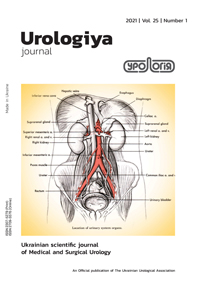What we know about outpatient urology in Europe
DOI:
https://doi.org/10.26641/2307-5279.25.1.2021.231359Abstract
Information on office urology and outpatient urology performed by urologists in main profession is scarce. The 2017 founded EAU Section ESUO of outpatient and office urologists has inquired through two questionnaires the number of outpatient urologists, the methods of outpatient urology (26 countries, 53 response items) and the working conditions of outpatient urologists (16 countries, 53 response items), in, in sum, 26 European countries and 106 response items. The questions covered the number of outpatient urologists, the role of subspecialties, own inpatient treatment, diagnostic methods (laboratory, imaging, instrumental diagnostics), non-oncological and oncological drug therapies, instrumental therapy, and outpatient surgery. The kind of employment, the institution of work of outpatient urologists and the sources of their salary were explored, as well as the extent of permits needed to fulfil their medical work and the nature of paces patients use to visit them.
The results show a total of 16,532 outpatient urologists in the 26 European countries from which information is already received. Thus, outpatient urology is an ever growing part of urology in Europe. A great variety and country-specific differences is seen in the methods outpatient urologists use to care for their patients. The evaluation of the data shows that “office urology” is only one of several ways in which outpatients are treated in Europe. These differences can be explained by the history and development of urology in the individual countries and country-specific demarcations against other specialties. The role of international organizations like the EAU in in promoting a common path is discussed. Outpatient urologists are as well employed as self-employed in offices, medical centres or hospitals. In different proportions, their salary comes from public and private health insurances and from the individual patient. Medicine is highly regulated by authorities, the individual workplace and by cooperating physicians with the need to obtain permits in different numbers.
The paths of patients to the urologist are described in relation to the sources of salary and the extent of cooperation among physicians, with surprising results. The tasks of outpatient urology in its role of a link between general medicine and urological clinic and an algorithm to allocate patients to the respective institution of care are discussed. Finally a view is given to recent developments in outpatient urology.
References
Kiely E.A. The European Board of Urology survey of current urological manpower, training and practice in Europe. BJU Int. 2000. Vol. 85, No. 1. P. 8–13. DOI: 10.1046/j.1464-410x.2000.00851.x.
Kiely E.A. An EBU Manpower Survey- How European Urology is Evolving. EUT. 2005. October.
Cek M., Kiely E.A. Results of the EBU Manpower Survey on office urology. EUT. 2007. Sept., 18. (19/5).
Haas H. A discussion of what we consider to be office urology. EUT. 2019. Oct/Dec, 15. (31/5).
Haas H. Varieties in Office Urology across Europe. EUT. 2018. Oct/Dec, 23. (30/5).
Haas H. Recognising the potentials of Office Urology. EUT. 2017. Mar/May, 10. (29/2).
Brenneis H., Dimitriadis F. Networking in the urological office. EUT. 2020. Aug/Sep, 37. (32/4).
Haensel S. The new General Data Protection Regulation. EUT Congress Edition. 2019. Mar, 15.
Downloads
Published
Issue
Section
License
Стаття повинна мати візу керівника та офіційне направлення від установи, з якої виходить стаття (з круглою печаткою), і вказівкою, чи є стаття дисертаційною, а також у довільній формі на окремому аркуші - відомості про авторів (прізвище, ім’я, по батькові, посада, вчений ступінь, місце роботи, адреса, контактні телефони, E-mail).
Стаття повина бути підписана всіма авторами, які укладають з редакцією договір пропередачу авторських прав (заповнюється на кожного автора окремо з оригінальним підписом). За таких умов редакція має право на її публікацію та розміщення на сайті видавництва.

